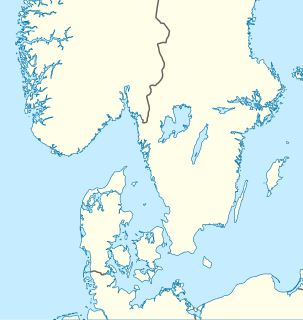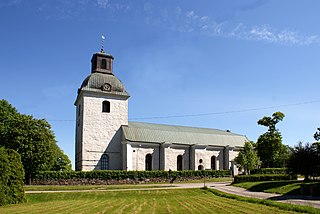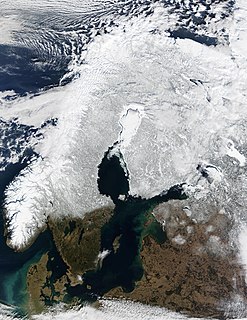
U 11 is the Rundata designation for a runestone that is located near the ruins of the old king's dwelling at Alsnö hus near Hovgården on the island of Adelsö in Sweden.

The runestone known as Östergötland Rune Inscription 179 or Ög 179, as listed in the Rundata catalog, stands on the east side of the Vadstena Abbey in Vadstena, Sweden. The stone is tinted red and is about 193 cm in height. The inscription is classified as being carved in runestone style Fp. This is the classification for runic bands that have attached serpent or beast heads depicted as seen from above.

The Skarpåker Stone, designated by Rundata as Sö 154, is a Viking Age memorial runestone that originally was located in Skarpåker, Nyköping, Sörmland, Sweden. It dates to the early eleventh century.

The England runestones is a group of about 30 runestones in Sweden which refer to Viking Age voyages to England. They constitute one of the largest groups of runestones that mention voyages to other countries, and they are comparable in number only to the approximately 30 Greece Runestones and the 26 Ingvar Runestones, of which the latter refer to a Viking expedition to the Middle East. They were engraved in Old Norse with the Younger Futhark.

The Viking runestones are runestones that mention Scandinavians who participated in Viking expeditions. This article treats the runestone that refer to people who took part in voyages abroad, in western Europe, and stones that mention men who were Viking warriors and/or died while travelling in the West. However, it is likely that all of them do not mention men who took part in pillaging. The inscriptions were all engraved in Old Norse with the Younger Futhark. The runestones are unevenly distributed in Scandinavia: Denmark has 250 runestones, Norway has 50 while Iceland has none. Sweden have as many as between 1,700 and 2,500 depending on definition. The Swedish district of Uppland has the highest concentration with as many as 1,196 inscriptions in stone, whereas Södermanland is second with 391
There were probably two Gunnar's bridge runestones at Kullerstad, which is about one kilometre northeast of Skärblacka, Östergötland County, Sweden, which is in the historic province of Östergötland, where a man named Håkon dedicated a bridge to the memory of his son Gunnar. The second stone was discovered in a church only 500 metres away and is raised in the cemetery. The second stone informs that Håkon raised more than one stone in memory of his son and that the son died vestr or "in the West."

The Gamla Turingevägen Inscriptions are two Viking Age memorial runic inscriptions and one image that are designated as Sö 311, Sö 312, and Sö 313 in the Rundata catalog, that are located in Södertälje, Stockholm County, Sweden, and in the historic province of Södermanland.

Runic inscription U 873 is the Rundata catalog number for a Viking Age memorial runestone that is located in Örsunda, which is about one kilometer west of Örsundsbro, Uppsala County, Sweden, which is in the historic province of Uppland.

Östergötland Runic Inscription 224 or Ög 224 is the Rundata catalog number for a Viking Age memorial runestone that is located in Stratomta, which is 9 kilometers east of Linköping, Östergötland, Sweden. The runestone has an inscription on two sides with an image of a ship on the south side.

Södermanland Runic Inscription 158 or Sö 158 is the Rundata catalog number for a Viking Age memorial runestone located in Österberga, which is one kilometer southwest of Ärsta and three kilometers southwest of Runtuna, Södermanland County, Sweden, and in the historic province of Södermanland. The inscription includes an image of a ship and uses same-stave bind runes to commemorate a man described as being a thegn.

Östergötland Runic Inscription MÖLM1960;230 or Ög MÖLM1960;230 is the Rundata catalog number for a memorial runestone that is located near a church in Törnevalla, which is 2 kilometers east of Linghem, Östergötland County, Sweden, which was in the historic province of Östergötland. The runestone has an inscription which refers to a Viking Age mercantile guild and depicts a ship.

The Bjälbo runestones are three Viking Age memorial runestones, one of which has been lost, located at Bjälbo, which is a village in Mjölby Municipality, Östergötland, Sweden. One of the inscriptions provides evidence of the existence of guilds in Sweden during this period.

The Bjäresjö Runestones are three Viking Age memorial runestones originally located adjacent to Bjäresjö Church in Bjäresjö, which is about 3 kilometers northwest of Ystad, Skåne County, Sweden. Two of the stones were discovered near the church, and two of the stones have been moved to other nearby locations. Although these three stones are located in Sweden, they have been given Danish designations because Scania was part of the historic Denmark.

The Fölene Runestones are two Viking Age memorial runestones which are located near the church in Fölene, which is about two kilometers west of Herrljunga, Västra Götaland County, Sweden, which was in the historic province of Västergötland. The stones are memorials to two men who were described as holding the title drengr.
The Bjärby Runestones are two Viking Age memorial runestones located near Grästorp, Sweden, in Bjärby synod, which was in the historic province of Västergötland. The two stones are memorials to men who held the titles thegn and drengr, and one has a depiction of the hammer of the Norse pagan deity Thor.

The Ovansjö Runestones are two Viking Age memorial runestones and fragments of a third that were found in a church in Ovansjö, which is east of Kungsgården, Gävleborg County, Sweden, which was in the historic province of Gästrikland.

The Sövestad Runestones consist of a Viking Age image stone and memorial runestone found near Krageholm Castle, which is about two kilometers west of Sövestad, Skåne County, Sweden.

The Aringsås Runestones are two runestones located at the Aringsås Church in Alvesta, Kronoberg County, Sweden, which was in the historic province of Småland. A third runestone is believed to be hidden within a churchyard wall.

Västergötland Runic Inscription 90 or Vg 90 is the Rundata listing for a Viking Age memorial runestone located in Torestorp, which is about three kilometers northwest of Gudhem, Västra Götaland County, Sweden, and in the historic province of Västergötland.


















